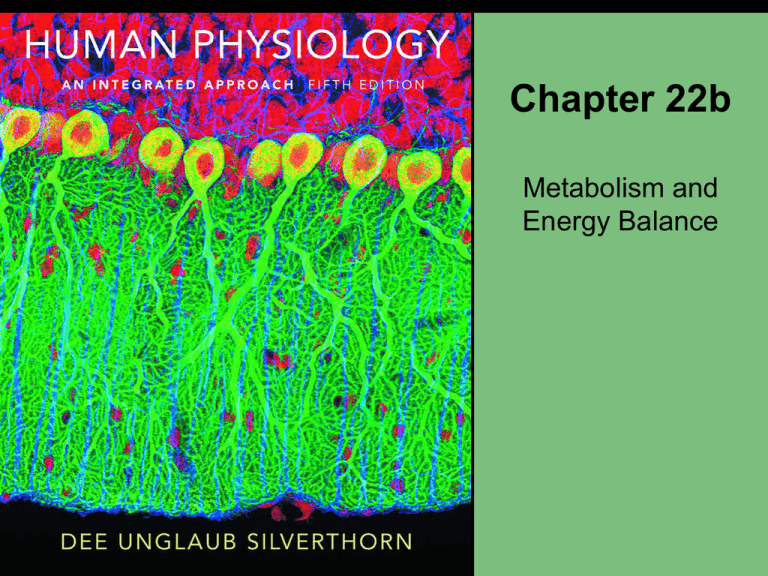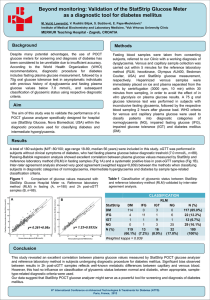Chapter 22b
advertisement

Chapter 22b Metabolism and Energy Balance Homeostatic Control of Metabolism • Endocrine pancreas secretes hormones insulin and glucagon. These control blood sugar. Figure 22-8a Homeostatic Control of Metabolism Figure 22-8b Homeostatic Control of Metabolism • In the fed state, high levels of plasma glucose and amino acids result in the secretion of insulin. • Note effects of insulin √ Figure 22-9a Homeostatic Control of Metabolism • In the fasting state, low plasma glucose results in the secretion of glucagon • Note effects of glucagon √ Figure 22-9b Homeostatic Control of Metabolism • Levels of glucose, glucagon, and insulin vary over a typical 24-hour period Figure 22-10 Factors That Control Insulin Secretion 1 - Increased plasma glucose 2 - Increased plasma amino acids 3 - Feedforward effects of GI hormones 4 - Parasympathetic activity 5 - Sympathetic activity Insulin Promotes Anabolism • Increases glucose transport into most, but not all, insulin-sensitive cells • Enhances cellular utilization and storage of glucose • Enhances utilization of amino acids • Promotes fat synthesis Glucose Uptake by Adipose Tissue and Resting Skeletal Muscle is Insulin-Sensitive • In the absence of insulin, glucose cannot enter cell Figure 22-12a Insulin Enables Glucose Uptake by Adipose Tissue and Resting Skeletal Muscle • Insulin signals the cell Figure 22-12b Insulin Indirectly Alters Glucose Transport in Hepatocytes • Hepatocyte in fed state Figure 22-13a Insulin Indirectly Alters Glucose Transport in Hepatocytes • Hepatocyte in fasted state Figure 22-13b Fed State: Insulin is an Anabolic Hormone • Insulin promotes • Glucose uptake • Glucose metabolism • Energy storage as glycogen and fat KEY Plasma glucose Stimulus Integrating center Efferent path cells of pancreas cells of pancreas Effector Tissue response Systemic response Insulin Liver Muscle, adipose, and other cells Glucose transport Glycolysis Glycogenesis Lipogenesis Negative feedback Plasma glucose Figure 22-14 Glucagon Is Dominant in the Fasted State • Glucagon is anatgonistic to most actions of insulin, resulting in a catabolic state in the body Figure 22-9b Endocrine Response to Hypoglycemia Figure 22-15 Diabetes Mellitus is a Family of Diseases • Diabetes mellitus is a condition characterized by chronic elevated plasma glucose levels, or hyperglycemia • Diabetes is reaching epidemic proportions in the USA • Complications of diabetes affect many body systems • The two types of diabetes are • • Type 1 - characterized by insulin deficiency Type 2 - known as insulin-resistant diabetes (cells cannot respond to the insulin in the body) Acute Pathophysiology of Type 1 Diabetes Mellitus ACUTE PATHOPHYSIOLOGY OF TYPE 1 DIABETES MELLITUS FAT METABOLISM GLUCOSE METABOLISM PROTEIN METABOLISM Meal absorbed • Overview • See pages 743 - 745 Plasma fatty acids Plasma amino acids Plasma glucose No insulin released Fat breakdown Glucose uptake (muscle and adipose) Fat storage Liver Plasma fatty acids Ketone production Substrate for ATP production Tissue loss Glucose utilization Glycogenolysis Gluconeogenesis Hyperglycemia METABOLIC ACIDOSIS Brain interprets as starvation Amino acid uptake by most cells Protein breakdown, especially muscle Plasma amino acids Substrate for ATP production Polyphagia Tissue loss DEHYDRATION Exceeds renal threshold for glucose Glucosuria Ventilation Osmotic diuresis and polyuria Metabolic acidosis Urine acidification and hyperkalemia Thirst Dehydration Lactic acid production Anaerobic metabolism Blood volume and Blood pressure Circulatory failure Polydipsia ADH secretion Attempted compensation by cardiovascular control center compensation fails Coma or death Figure 22-16 Acute Pathophysiology of Type 1 Diabetes Mellitus ACUTE PATHOPHYSIOLOGY OF TYPE 1 DIABETES MELLITUS FAT METABOLISM GLUCOSE METABOLISM PROTEIN METABOLISM Meal absorbed 1 - Absorption of nutrients is normal Plasma fatty acids Plasma glucose Plasma amino acids Figure 22-16 (1 of 8) Acute Pathophysiology of Type 1 Diabetes Mellitus ACUTE PATHOPHYSIOLOGY OF TYPE 1 DIABETES MELLITUS FAT METABOLISM GLUCOSE METABOLISM PROTEIN METABOLISM Meal absorbed 2a (protein) Most cells unable to absorb nutrients shift to fasted state metabolism Plasma fatty acids Plasma glucose Plasma amino acids No insulin released Amino acid uptake by most cells Liver Protein breakdown, especially muscle Plasma amino acids Substrate for ATP production Tissue loss Figure 22-16 (2 of 8) Acute Pathophysiology of Type 1 Diabetes Mellitus ACUTE PATHOPHYSIOLOGY OF TYPE 1 DIABETES MELLITUS FAT METABOLISM GLUCOSE METABOLISM PROTEIN METABOLISM Meal absorbed 2b (fat) - Most cells unable to absorb nutrients shift to fasted state metabolism Plasma fatty acids Plasma glucose Plasma amino acids No insulin released Fat breakdown Plasma fatty acids Substrate for ATP production Tissue loss Amino acid uptake by most cells Fat storage Liver Ketone production Protein breakdown, especially muscle Plasma amino acids Substrate for ATP production Tissue loss Figure 22-16 (3 of 8) Acute Pathophysiology of Type 1 Diabetes Mellitus ACUTE PATHOPHYSIOLOGY OF TYPE 1 DIABETES MELLITUS FAT METABOLISM GLUCOSE METABOLISM PROTEIN METABOLISM Meal absorbed 3Hyperglycemia results when liver cells also shift to the fasted state, and produce more glucose! Plasma fatty acids Plasma glucose Plasma amino acids No insulin released Fat breakdown Fat storage Plasma fatty acids Substrate for ATP production Tissue loss Glucose uptake (muscle and adipose) Glucose utilization Liver Ketone production Glycogenolysis Amino acid uptake by most cells Protein breakdown, especially muscle Plasma amino acids Gluconeogenesis Hyperglycemia Substrate for ATP production Tissue loss Figure 22-16 (4 of 8) Acute Pathophysiology of Type 1 Diabetes Mellitus ACUTE PATHOPHYSIOLOGY OF TYPE 1 DIABETES MELLITUS FAT METABOLISM GLUCOSE METABOLISM PROTEIN METABOLISM Meal absorbed 3b – More glucose results in polyphagia Plasma fatty acids Plasma amino acids Plasma glucose No insulin released Fat breakdown Fat storage Plasma fatty acids Substrate for ATP production Tissue loss Glucose uptake (muscle and adipose) Glucose utilization Liver Ketone production Glycogenolysis Gluconeogenesis Hyperglycemia Brain interprets as starvation Polyphagia Amino acid uptake by most cells Protein breakdown, especially muscle Plasma amino acids Substrate for ATP production Tissue loss Figure 22-16 (5 of 8) Acute Pathophysiology of Type 1 Diabetes Mellitus ACUTE PATHOPHYSIOLOGY OF TYPE 1 DIABETES MELLITUS FAT METABOLISM GLUCOSE METABOLISM PROTEIN METABOLISM Meal absorbed 4a Hyperglycemia results in glucose in the urine and increased urine production Plasma fatty acids Plasma amino acids Plasma glucose No insulin released Fat breakdown Fat storage Plasma fatty acids Substrate for ATP production Glucose uptake (muscle and adipose) Glucose utilization Liver Ketone production Glycogenolysis Gluconeogenesis Hyperglycemia Tissue loss Brain interprets as starvation Polyphagia Amino acid uptake by most cells Protein breakdown, especially muscle Plasma amino acids Substrate for ATP production Tissue loss Exceeds renal threshold for glucose Glucosuria Osmotic diuresis and polyuria Figure 22-16 (6 of 8) Acute Pathophysiology of Type 1 Diabetes Mellitus ACUTE PATHOPHYSIOLOGY OF TYPE 1 DIABETES MELLITUS FAT METABOLISM GLUCOSE METABOLISM PROTEIN METABOLISM Meal absorbed 4b – And then low blood pressure as a result of dehydration Plasma fatty acids Plasma amino acids Plasma glucose No insulin released Fat breakdown Fat storage Plasma fatty acids Substrate for ATP production Glucose uptake (muscle and adipose) Glucose utilization Liver Ketone production Glycogenolysis Gluconeogenesis Hyperglycemia Tissue loss Brain interprets as starvation Amino acid uptake by most cells Protein breakdown, especially muscle Plasma amino acids Substrate for ATP production Polyphagia Tissue loss DEHYDRATION Exceeds renal threshold for glucose Glucosuria Osmotic diuresis and polyuria Thirst Dehydration Blood volume and Blood pressure Polydipsia ADH secretion Attempted compensation by cardiovascular control center Figure 22-16 (7 of 8) Acute Pathophysiology of Type 1 Diabetes Mellitus ACUTE PATHOPHYSIOLOGY OF TYPE 1 DIABETES MELLITUS FAT METABOLISM GLUCOSE METABOLISM PROTEIN METABOLISM Meal absorbed 5 - Metabolic acidosis results, which if untreated can lead to coma and/or death Plasma fatty acids Plasma amino acids Plasma glucose No insulin released Fat breakdown Glucose uptake (muscle and adipose) Fat storage Liver Plasma fatty acids Ketone production Substrate for ATP production Tissue loss Glucose utilization Glycogenolysis Gluconeogenesis Hyperglycemia METABOLIC ACIDOSIS Brain interprets as starvation Amino acid uptake by most cells Protein breakdown, especially muscle Plasma amino acids Substrate for ATP production Polyphagia Tissue loss DEHYDRATION Exceeds renal threshold for glucose Glucosuria Ventilation Osmotic diuresis and polyuria Metabolic acidosis Urine acidification and hyperkalemia Thirst Dehydration Lactic acid production Anaerobic metabolism Blood volume and Blood pressure Circulatory failure Polydipsia ADH secretion Attempted compensation by cardiovascular control center compensation fails Coma or death Figure 22-16 (8 of 8) Type 2 Diabetes • Accounts for 90% of all diabetics • Insulin resistance (target cells do not respond normally) • Early symptoms are mild, but later complications include atherosclerosis, neurological changes, renal failure, and blindness • Therapy • Diet and physical exercise • Drugs Glucose Tolerance Test Figure 22-17 Drugs Attempt to Treat Diabetes by Varying Mechanisms Table 22-6 Metabolic Syndrome - Insulin resistance syndrome • Patients have combined symptoms of type 2 diabetes, atherosclerosis, and high blood pressure • Diagnostic criteria - three or more of • • • • • Central (visceral) obesity Blood pressure ≥ 130/85 mm Hg Fasting blood glucose ≥ 110 mg/dL Elevated fasting plasma triglyceride levels Low plasma HDL-C levels Fats • Assembled into chylomicrons in SI lining • Into lymphatics to blood to liver • Liver processes into lipoproteins LDL’s • LDL’s to cells for use in synthesis of cholesterol • Likely leads to atherosclerosis • HDL’s depleted of cholesterol tend to return to liver for processing into bile for excretion – lowers cholesterol • HMG coA reductase inhibitors – Big $$ • statins – lipitor lovastatin also other cholesterol treatments: fibrates and niacin Fat catabolism • Ketosis • Excessive leads to metabolic acidosis • FA catabolized into ketone bodies two carbons at a time – ß - oxidation Body Temperature: Energy Balance in the Body ENERGY INPUT DIET • Hunger/appetite • Satiety • Social and psychological factors ENERGY OUTPUT HEAT (~50%) • Unregulated • Thermoregulation WORK (~50%) • Transport across membranes • Mechanical work Movement • Chemical work • Synthesis for growth and maintenance • Energy storage • High-energy phosphate bonds (ATP, phosphocreatine) • Chemical bonds (glycogen, fat) Figure 22-18 Body Temperature: Heat Balance in the Body EXTERNAL HEAT INPUT + INTERNAL HEAT PRODUCTION = HEAT LOSS Evaporation Radiation Radiation heat input Conduction Body heat heat loss Conduction Convection Internal heat production heat production From From muscle metabolism contraction “Waste ? Nonshivering Shivering “Waste heat” thermogenesis thermogenesis heat” Regulated processes for temperature homeostasis Figure 22-19 Body Temperature: Thermoregulatory Reflexes Figure 22-20 (1 of 2) Body Temperature: Thermoregulatory Reflexes Figure 22-20 (2 of 2) Mechanisms of Body Temperature Regulation • Neural control of cutaneous blood flow alters heat loss through the skin • Sweat contributes to heat loss • Heat production • Voluntary muscle contraction and normal metabolism • Regulated heat production • Shivering versus nonshivering thermogenesis Homeostatic Responses to High Temperature Figure 22-21 (1 of 2) Homeostatic Responses to Low Temperature Figure 22-21 (2 of 2) Regulation of Body Temperature • Our hypothalamic thermostat can be reset • Typical physiological variations • Fever occurs when pyrogens reset the thermostat • Pathological cases of altered body temperature • Hyperthermia - compare • Heat exhaustion • Heat stroke • Heat exhaustion is characterized by significant sweating, loss of color, cramps, fatigue, fainting and dizziness. • Heat stroke symptoms include a body temperature over 103, dry skin, high heart rate, confusion and even unconsciousness • Malignant hyperthermia • Hypothermia • Diving reflex √ Summary • Appetite and Satiety • Feeding and satiety centers, glucostatic versus lipostatic theories, regulation of food intake by numerous regulatory peptides • Energy Balance • Definition of energy balance, bodily uses for energy, direct calorimetry, oxygen consumption, RQ, RER, BMR, diet-induced thermogenesis, glycogen and fat as two major forms of stored energy Summary • Metabolism • Anabolic pathways versus catabolic pathways, fed state versus fasted state, glycogenesis, glycogenolysis, and gluconeogenesis • Chylomicrons, lipoprotein lipase, apoproteins A and B, LDL-C, risks factors for heart disease, beta oxidation and ketone bodies Summary • Homeostatic Control of Metabolism • Ratio of insulin to glucagon, Islets of Langerhans, insulin-receptor substrates, major targets and effects of insulin, glucagon and the fasted state, diabetes mellitus, and metabolic syndrome • Regulation of body temperature • Hypothalamic thermostat, routes and mechanisms of heat loss, shivering thermogenesis and nonshivering thermogenesis








